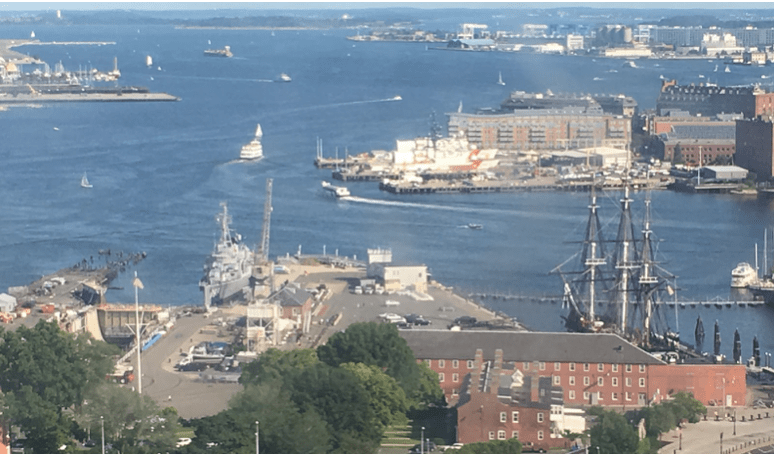By Hannah Marcel
As summer rolls on here at Boston National Historical Park, so do the opportunities for learning! Work has continued on the annual inventory of the park and we have recently been focused on tracking down items on the accession inventory. This involved referencing the accession paperwork and previous inventories to gain context on the artifacts that we are locating. I have also been given the opportunity to participate in the examination of artifacts that have been sent to the park for potential accession. These projects have allowed me to gain a better understanding of the National Park Service accession process. I also participated in the housekeeping of artifact storage spaces, which included dusting, wiping down surfaces, vacuuming floors and shelf covers, and ensuring that the space is clean overall.
The recent project that I am most excited for, however, is the creation of a new exhibit panel to be displayed in the Bunker Hill Museum. This process started out with research to better understand the subject of the exhibit panel, two timbers from the apparatus used to build the first 37 feet of the Bunker Hill Monument. This allowed us to identify key points to share with the public when creating the exhibit panel. A lot goes in to exhibit creation that many people do not think about, including ADA accessibility. Participating in this process has allowed me to learn more about the guidelines that go into making exhibit panels that are not just engaging and informative, but accessible to as many visitors as possible.
Researching for this exhibit panel forced me to think critically about what went into the construction of the monument, whose height and obelisk shape was the first of its kind. (The Washington Monument would not be completed until 1848). The cornerstone of the monument was laid by Marquis De Lafayette in 1825, and the entire structure was completed in 1842. To get every Quincy granite block into place required clever design and meticulous equipment. Not only was the construction itself a feat of architecture, but so was the organization that went into funding the monument. I was able to reflect on this as I made the climb to the top, yes all 294 stairs! Even though I have made this climb a few times as a child, I had been putting it off for most of my visit. You tell me who really wants to climb 294 stairs, roughly 18 flights, in the middle of summer! Despite my reluctance, this felt like the right time to go, having researched the massive effort that went into this structures creation. The view of Boston from the top of the monument, almost made the climb worth it! So many people came together, including women, to make that monument possible.

Figure 2: Zoomed in view of the Charlestown Navy Yard from the top of the Monument, on the left is the USS Cassin Young and on the right is the USS Constitution
Dive Deeper:
What struck me the most was the role that everyone in New England, and beyond, played in the construction of the Bunker Hill Monument. This included the efforts of women and children across the region who banded together to raise the funds necessary for the project. So how did it all come to be?
Before there was the 221-foot tall obelisk commemorating the Battle of Bunker Hill, there was a monument honoring fallen patriot and Freemason Dr. Joseph Warren. Despite his status as a general, Dr. Warren insisted on fighting as a private during the battle because he believed other generals present had more experience, resulting in his death. In 1794, a group of Freemasons decided to build a memorial for their fellow Freemason, a replica of which sits in the bottom of the monument today. Despite this, citizens of New England felt that more should be done to honor those that had fought in the Battle of Bunker Hill. In 1823, the Bunker Hill Monument Association was formed to create a more substantial monument on the battlefield. Funding this memorial would prove to be a challenge, halting construction twice and forcing the Bunker Hill Monument Association to sell off a large portion of the battlefield to fund the project. This would not be enough however, leading a couple of wealthy donors and the women of New England to step up and fund the project.

Figure 3: Replica of the original monument to Dr. Warren & Statue of Dr. Warren located in the Bunker Hill Lodge
Motivation for the women of New England to raise these funds came from Sarah J. Hale, the influential editor of the magazine Godey’s Lady’s Book. Hale wrote Bunker Hill Monument Association asking if she could utilize her position to motivate the women of New England to raise the funds. Some felt that the women would be overstepping their position and would likely take the money from their husbands who had already donated anyway. Despite these criticisms, the association voted in favor of Hale’s offer. Women and children from all over New England donated funds and hand crafted objects to be sold at the week long Ladies Fair to fundraise. In total, Hale’s efforts raised over $30,000 for the monument, joining the contributions of Amos Lawrence and Judah Touro, who each donated $10,000.

Figure 4:
The exhibit panel in the Bunker Hill Museum discussing Sarah J. Hale. On display is a book of subscriptions received for the monument, a copper medal from the Ladies Fair, and a doll. In the exhibit is also a copy of Sarah J Hale’s original plea beginning with the words “To the women of New England”
Wall Text, Founder and Fairs, Bunker Hill Monument Museum, Charlestown, Boston Massachusetts.
“Bunker Hill Monument.” National Parks Service. Accessed July 19, 2019. https://www.nps.gov/bost/learn/historyculture/bhm.htm.
“The History of the Bunker Hill Monument Association during the First Century of the United States of America : Warren, George Washington, 1813-1883 : Free Download, Borrow, and Streaming.” Internet Archive, Boston : J. R. Osgood, 1 Jan. 1877, archive.org/details/historyofbunkerh00warr.
(Note: There is a copy of “The History of the Bunker Hill Monument Association during the First Century of the United States of America” in the Boston National Historical Park collection however I chose to use a digital copy from the Library of Congress Archives to avoid having to add wear to the book)


